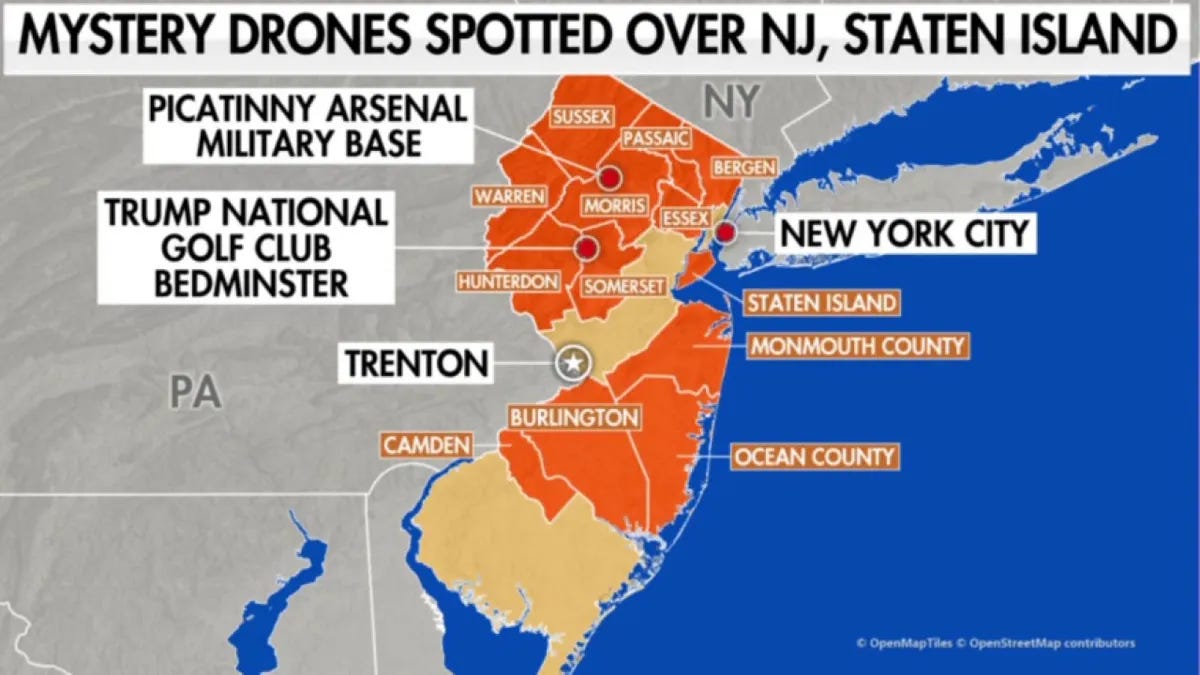Hey we made it to 50!? In order to make it easier to reference back issues we’re gonna start numbering them. Please share this issue with friends and enemies!
On quiet nights in New Jersey, the skies have been anything but. Since mid-November, reports of large, unidentified drones have dominated local news. Residents describe swarms of aircraft hovering over homes, sensitive sites, and critical infrastructure, moving with eerie precision and no apparent source. These machines, some as large as six feet in diameter, have sparked questions that remain unanswered by both state and federal authorities. But here’s the rub: while officials claim ignorance, their lack of concern suggests otherwise. Is this an institutional failure, or is there something they’re not telling us?
The paradox at the heart of this story exposes the growing chasm between authority and transparency. On the one hand, government agencies insist they do not know who is operating these drones. On the other, their muted response—no declarations of public safety risks, no emergency orders—hints that they might, in fact, know exactly what’s happening. This contradiction undermines the public’s trust and fuels a deeper anxiety: if they know, why won’t they tell us? And if they don’t, how can they govern an airspace they can’t control?
Private Enterprise at Play?
The simplest explanation may be the most unsettling: this is likely the work of private enterprise. The U.S. defense-industrial complex has embraced private companies as innovation hubs, enabling them to test cutting-edge technologies under a shroud of secrecy. Among the likely candidates, one name looms large: Anduril Industries, the defense-tech startup helmed by Palmer Luckey, the controversial founder of Oculus. Known for its autonomous systems and battlefield-ready drones, Anduril has become a key player in modernizing U.S. defense capabilities.
Potential Private Actors:
Anduril Industries: With its autonomous drone systems and aggressive expansion into government contracts, Anduril is a natural suspect. The company’s ethos is rooted in pushing boundaries, both technological and regulatory.
General Atomics: Known for military drones like the MQ-9 Reaper, this firm could be testing new, smaller systems domestically.
Skydio: A rising star in autonomous drones, Skydio has been expanding its work with federal agencies.
AeroVironment: Specializes in tactical drones for reconnaissance and combat, often working closely with the U.S. military.
The Ukraine Effect
The conflict in Ukraine has rewritten the rules of drone warfare. The rapid deployment of commercial and military drones on the battlefield has demonstrated their transformative power. Cheap, autonomous systems can disrupt traditional defenses and level asymmetries between adversaries. For the U.S., this has been both an inspiration and a wake-up call. As adversaries like Russia and China learn from Ukraine’s drone proliferation, the pressure is mounting for the U.S. to innovate—fast.
The New Jersey drones, though sensational domestically, may well be part of this broader evolution. Their real audience might not be the residents of New Jersey but foreign adversaries. By testing advanced capabilities in a domestic environment, these flights could serve as a message: the U.S. is not only catching up but preparing for a new era of unmanned conflict.
Private Power vs Public Authority
This saga leaves the U.S. government facing a profound challenge to its authority. The public is witnessing a series of events that demand answers, yet none are forthcoming. The government’s silence—whether from ignorance or intentional obfuscation—creates a vacuum that erodes trust.
This lack of transparency is more than a PR problem; it’s a crisis of governance. How can a government claim to safeguard its citizens when it cannot (or will not) account for the machines flying over their heads? And what does it mean for the future of authority when private enterprises wield technologies that outpace public understanding and oversight?
As these drones continue to haunt New Jersey’s skies, they’ve become a symbol of a deeper conflict: the struggle between innovation and accountability, between private power and public authority. This is not just a story about drones; it’s a story about who controls the future.




